Attached files
| file | filename |
|---|---|
| 8-K - 8-K - Ra Pharmaceuticals, Inc. | a17-10886_18k.htm |
Exhibit 99.1
Next Generation Therapeutics for Disorders of Complement Regulation April 2017

Forward Looking Statements This presentation contains "forward-looking statements" within the meaning of the Private Securities Litigation Reform Act of 1995, including, but not limited to, statements regarding the safety, efficacy and regulatory and clinical progress of our product candidates, including RA101495. All such forward-looking statements are based on management's current expectations of future events and are subject to a number of risks and uncertainties that could cause actual results to differ materially and adversely from those set forth in or implied by such forward-looking statements. These risks and uncertainties include the risks that Ra Pharma’s product candidates, including RA101495, will not successfully be developed or commercialized; as well as the other factors discussed in the “Risk Factors” section in Ra Pharma’s most recently filed Annual Report on Form 10-K, as well as other risks detailed in Ra Pharma’s subsequent filings with the Securities and Exchange Commission. There can be no assurance that the actual results or developments anticipated by Ra Pharma will be realized or, even if substantially realized, that they will have the expected consequences to, or effects on, Ra Pharma. All information in this presentation is as of the date of the release, and Ra Pharma undertakes no duty to update this information unless required by law. 2
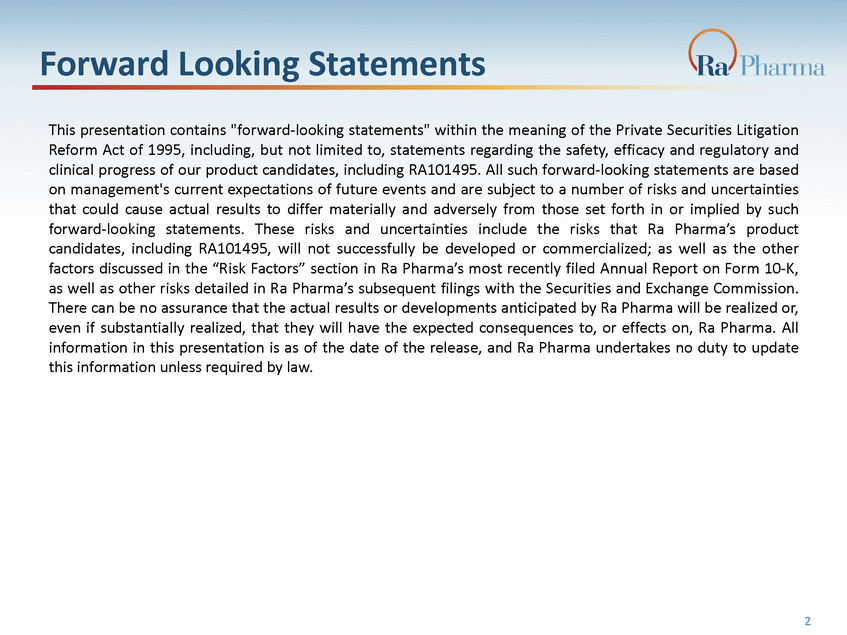
Overview Focused on complement-mediated diseases Addressing rare hematologic, renal, neurologic indications, as well as ocular and autoimmune Lead clinical program: RA101495 for paroxysmal nocturnal hemoglobinuria (PNH) Potent, synthetic macrocyclic peptide inhibitor of complement C5; Distinct binding site vs. eculizumab Convenient self-administered subcutaneous dosing Completed Phase 1 safety, PK, and PD study in healthy volunteers –Rapid, sustained, near complete suppression of hemolysis and complement activity Received orphan drug designation from European Medicines Authority (EMA) Phase 2: Regulatory clearance from FDA and ex-US agencies, Institutional Review Board (IRB) approvals received, site activation underway, dosing to commence shortly Powerful proprietary drug discovery engine Enables application to diseases with high unmet medical need and/or for which only mAbs have previously been successful Delivered orally-available peptides for a non-complement cardiovascular target with a large market opportunity in our collaboration with Merck $117.8 million in cash and cash equivalents as of December 31, 2016 $105.4 million gross proceeds raised in October 2016 initial public offering 3
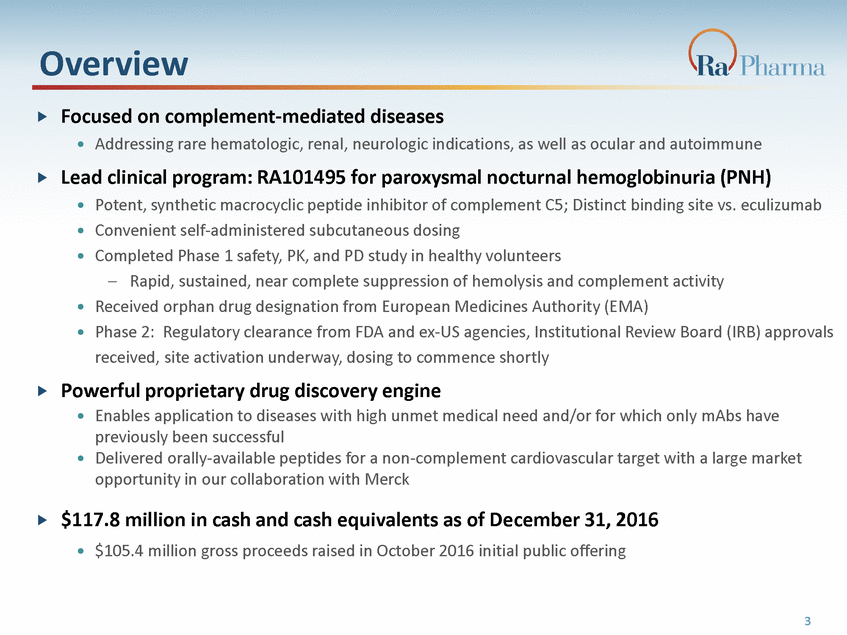
Leadership Team Doug Treco, PhD Co-Founder, President and CEO Ramin Farzaneh-Far, MD Chief Medical Officer David Lubner EVP, Chief Financial Officer Simon Read, PhD Chief Scientific Officer Alonso Ricardo, PhD SVP, Head of Research Jack W. Szostak, PhD Co-Founder 4
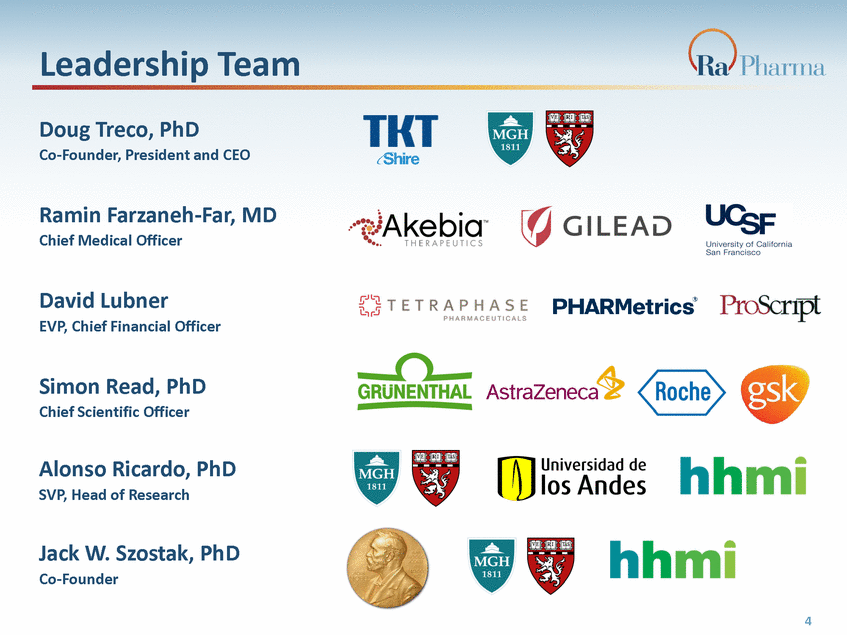
Pipeline (1) Developing an extended release formulation to allow for potential weekly dosing. (2) Leveraging preclinical, CMC and Phase 1 data packages to advance RA101495 in rMG and LN. 5 C5 Inhibition DISCOVERY PRECLINICAL PHASE 1 PHASE 2 RA101495 (PNH; SC) (1) RA101495 (Refractory Myasthenia Gravis; SC) (2) RA101495 (Lupus Nephritis; SC) (2) Oral Small Molecule Inhibitor (PNH, rMG, LN, CNS diseases) Factor D Inhibition Dry AMD/GA (intravit.), orphan renal diseases, (SC) C1 Inhibition Autoimmune/CNS Diseases Partnered Program (Non-Complement target) Oral macrocyclic peptide (Cardiovascular target with a large market opportunity)
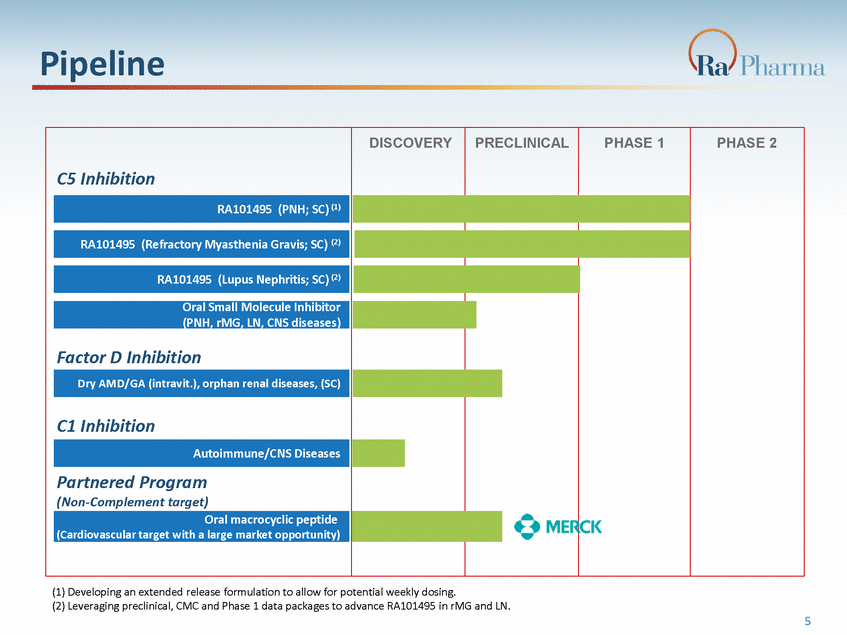
Q Ra PhaTTna The Complement Pathway A Target-Rich Opportunity for Leveraging our Proprietary Platform Alternative Pathway Classical Pathway Lectin Pathway Activated by non-self cells Activated by antibody-antigen complexes Activated by pathogen surfaces Cciq··c:1··c -1··1 C3 A:f Factor B C2,C3,C4 -CSa Proinflammatory cytokine C6 PNH: rupture of RBC C5b6 C7,C8,C9 eculizumab BindsCS RA101495 Binds CS & CSb rMG:destruction of neuromuscular junction MAC + LN: inflammation of kidney glomerulus Factor targeted by Ra Pharma product candidates 6 RA101495: Blocks CS cleavage and production of C5a and C5b-Same outcome as eculizumab supports similar clinical efficacy Blocks interaction of C5b with C6 and MAC formation-Unique property May be beneficial in hypercoagulative and inflammatory states, where thrombin and other proteases can cleave CS

Our Extreme Diversity™ Platform 7
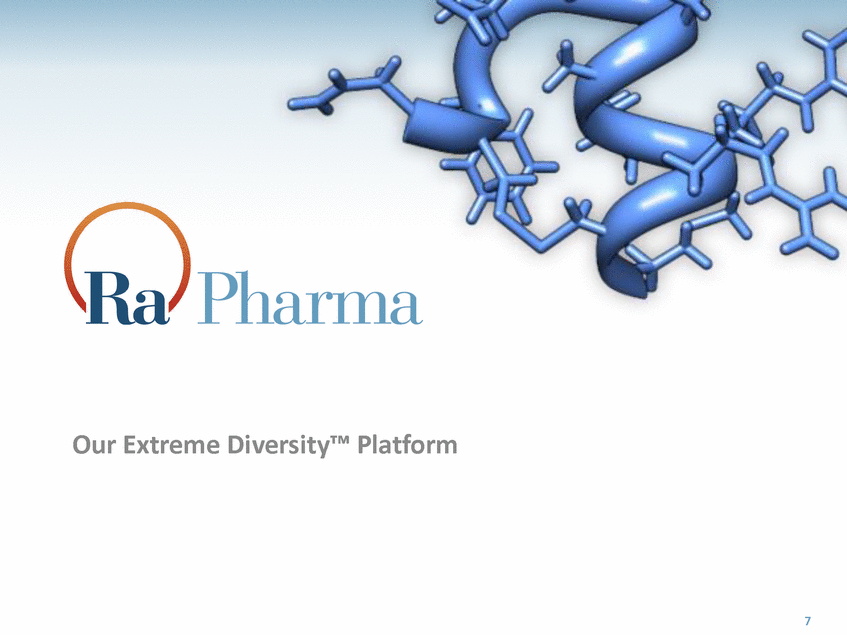
mRNA Display Platform: A New Approach to Building Drug-like Peptide Libraries and non-natural amino Cyclize to create macrocyclic peptides, convert mRNA to cDNA Large and diverse library of macrocycle peptide-cDNA fusions Large and diverse library of peptide-mRNA fusions P P Affinity selection to immobilized target Translation of mRNA to peptides to create peptide-mRNA fusion mRNA library with 3’ Puromycin (P) P P Copy DNA into mRNA and attach puromycin PCR amplify cDNA to produce large quantities of corresponding DNA Macrocyclic peptide-cDNA fusions bound to immobilized target Sequence DNA and synthesize peptide candidates Optimize Hits DNA corresponding to selected peptides 8 Drug Lead Candidate Peptides Translation with natural acids and cyclization to increase stability, potency, cell permeability, and bioavailability Rapid lead generation capabilities Utility Filling unmet needs associated with current monoclonal antibody, biologic, and peptide therapies Ability to distinguish between closely related targets Modulators of the undruggable proteome: Disrupt intracellular protein-protein interactions

RA101495 in Paroxysmal Nocturnal Hemoglobinuria (PNH) 9
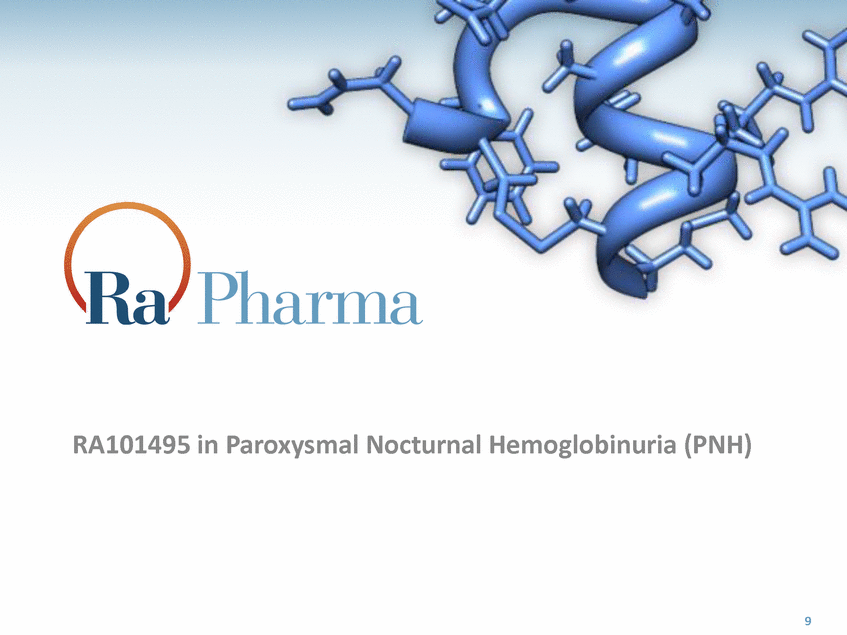
RA101495: Paroxysmal Nocturnal Hemoglobinuria (PNH) Rare, chronic, acquired hematologic syndrome where red blood cells (RBCs) are destroyed by the complement system ~16,000 patients worldwide Results in death of 35% of patients within 5 years and 50% within 10 years of diagnosis Most common cause of mortality is thrombosis Only 1 approved therapy: anti-complement C5 monoclonal antibody [eculizumab (Soliris®); Alexion] Biweekly IV infusion Approved for PNH and atypical hemolytic uremic syndrome (aHUS) 2016 revenues: ~$2.8B Straightforward clinical endpoints Markers of hemolysis, hemoglobin levels, transfusion requirements Strong correlation between level of hemolysis suppression and clinical benefit 10
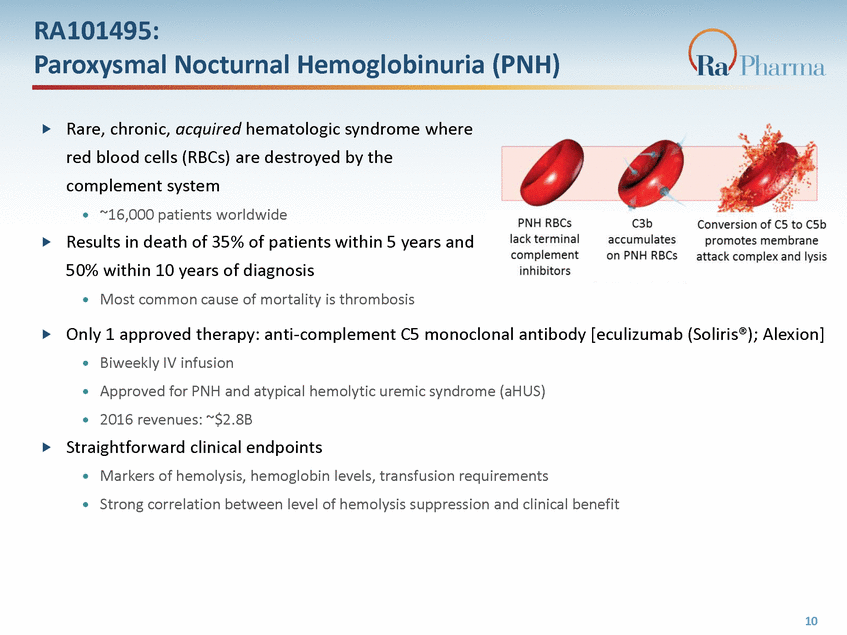
RA101495: Binds a Site on C5 That is Distinct From Eculizumab RA101495 binds in this region 11 Distinct from eculizumab binding site—allows treatment of patients with R885H/C mutations Peptides targeting novel druggable sites provide a toolkit for developing true small molecule inhibitors of C5

RA101495: Clinical Development Overview Phase 1, placebo-controlled, single-ascending dose and multiple dose study in healthy volunteers completed 2Q2016 Highly predictable PK after single and multiple SC injections, with dose dependent exposure Suppression of (ex vivo) hemolysis and complement activity was rapid, near-complete and sustained Single and repeat doses of RA101495 were well tolerated in healthy volunteers Open-label Phase 2 global program in up to 28 patients Naïve patients, patients who are currently treated with eculizumab, and patients who respond inadequately to eculizumab Regulatory clearance and IRB approvals received, site activation underway Dosing to commence shortly; Data readouts planned mid-year and year-end 2017 Plan to pursue other indications, Refractory Myasthenia Gravis (rMG) and Lupus Nephritis (LN) in parallel 2015 2016 2017 2018 oC for PD effects HV) 2 (PNH pts) Ph 2 extension planned (MG) Ph 1b (LN) 12 Ph 1 ( Plan P prot Plan Ph P ned ocol Ph 2 ned
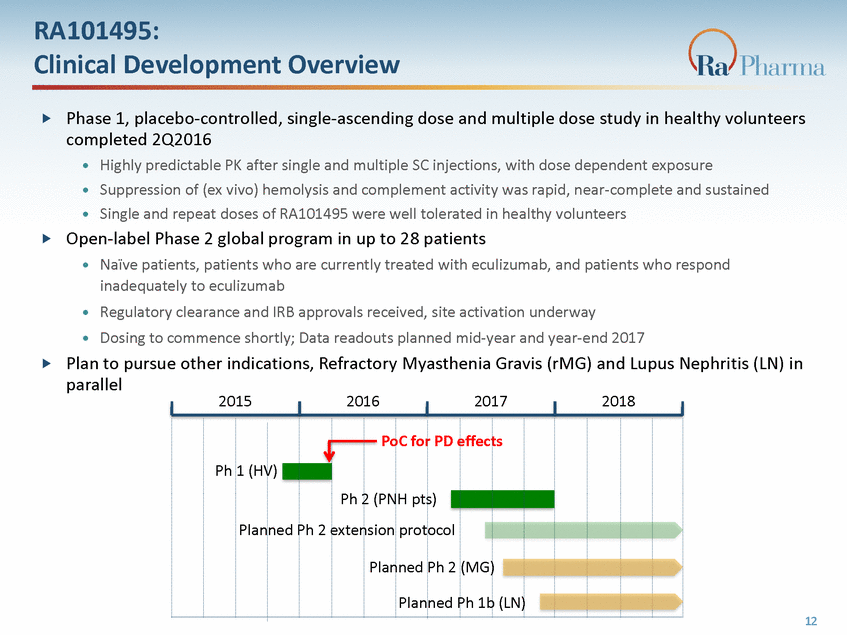
RA101495: Phase 1 Study Single-Ascending Dose Cohorts in Healthy Volunteers Randomized, placebo-controlled, double-blind, safety and dose finding study in healthy volunteers (n=22) 48 hours in-patient monitoring Cohort 1 n=2 RA101495 n=2 Placebo Cohort 2 n=4 RA101495 n=2 Placebo Cohort 3 n=4 RA101495 n=2 Placebo Cohort 4 n=4 RA101495 n=2 Placebo One center: Australia 13 0.4mg/kg 0.2mg/kg 0.1mg/kg 0.05mg/kg Ciprofloxacin prophylaxis Cipro + Neisseria vaccination 4 week follow up to assess safety and collect PK/PD data
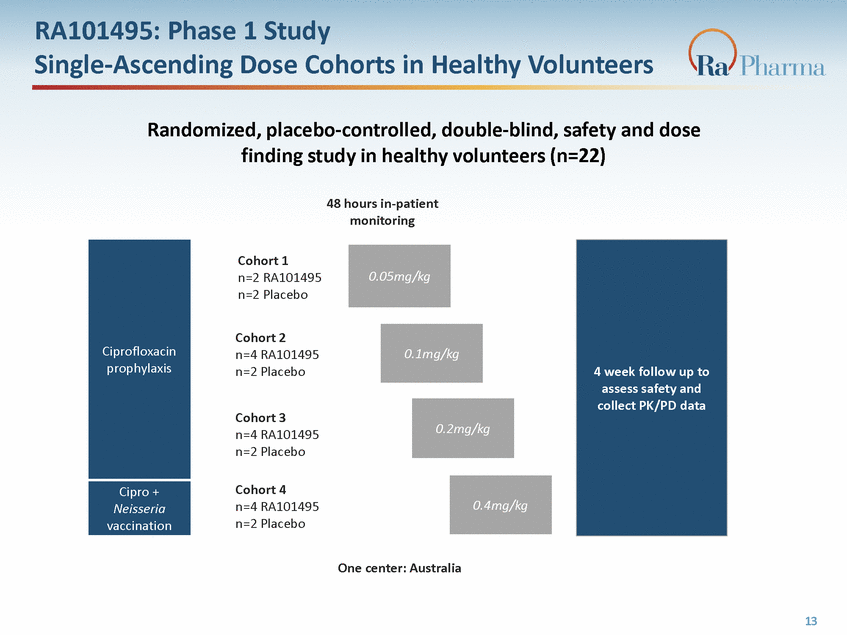
RA101495: Pharmacokinetics Predictable, Dose-Dependent Exposure After Single SC Injections Linear relationship observed between Cmax and dose level Approximate terminal half-life across all cohorts is 7 days RA101495 Pharmacokinetics consistent with predicted values from in silico PK model generated using data from non-human primate (NHP) studies Actual Drug Levels (In Vivo) n=2 (0.05 mg/kg) or 4 (0.1-0.4 mg/kg) per group 14 0 . 0 5 m g / k g 0 . 1 m g / k g 0 . 2 m g / k g 0 . 4 m g / k g
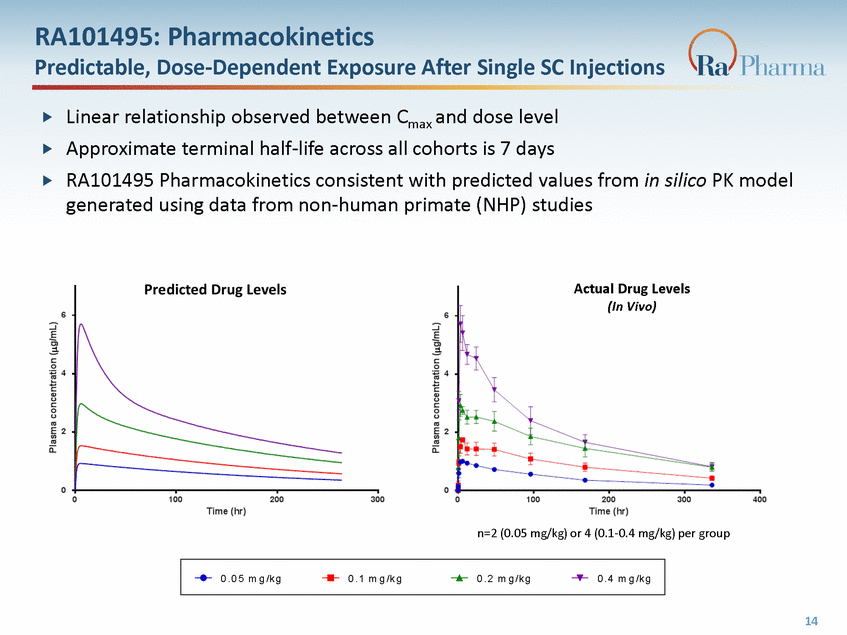
RA101495: Pharmacodynamics Strong Suppression of Hemolysis and Complement Activity After Single SC Injections Direct Hemolysis After a single dose, RA101495 exhibited a rapid dose-dependent inhibition of ex vivo hemolysis and suppression of complement activity in all subjects Maximum PD effect observed ~3h to ~ 6h after dosing A single dose of RA101495 at 0.4 mg/kg resulted in >90% suppression of hemolysis for at least 4 days in some subjects Sustained inhibition of hemolysis at highest dose suggests possibility of less frequent dosing MAC Immunoassay %CH50 0 . 0 5 m g / k g 0 . 1 m g / k g 0 . 2 m g / k g 0 . 4 m g / k g 0 . 0 5 m g / k g 0 . 1 m g / k g 0 . 2 m g / k g 0 . 4 m g / k g 1 0 0 0 . 0 5 m g / k g 0 . 1 m g / k g 0 . 2 m g / k g 1 0 0 0 . 0 5 m g / k g 1 0 0 15 n=2 (0.05 mg/kg) or 4 (0.1-0.4 mg/kg) 0p.e1rmgrgo/ kugp s i s o l y s i s e m o l y s i s
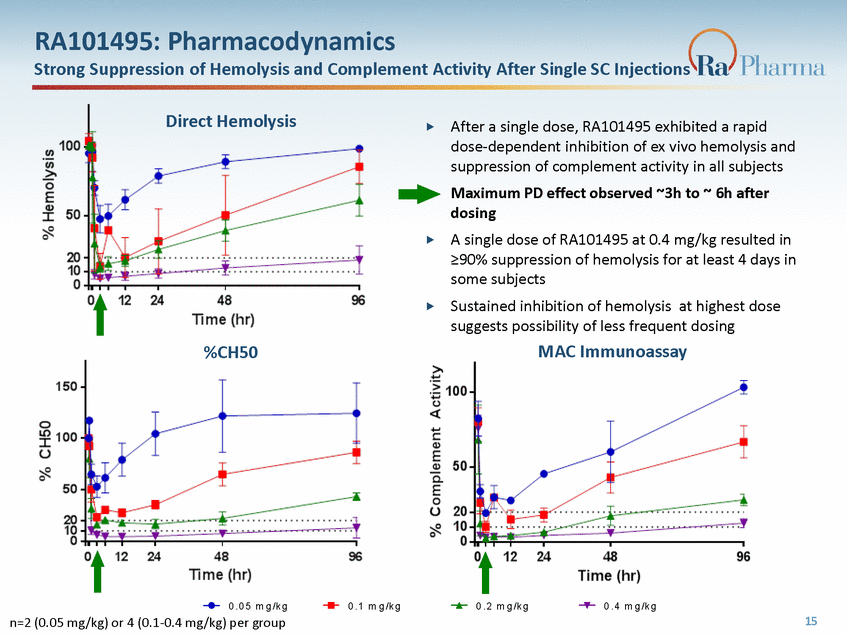
RA101495: Phase 1 Study Multiple-Dose Cohort in Healthy Volunteers Randomized, double-blind, placebo-controlled, multiple-dose study of safety, PK, and PD in healthy volunteers 7 daily doses (8 days in-patient monitoring) n=6 Placebo n=2 0.2 mg/kg n=4 One center: Australia 16 Ciprofloxacin prophylaxis + Neisseria vaccination 4 week follow up to assess safety and collect PK/PD data Randomize
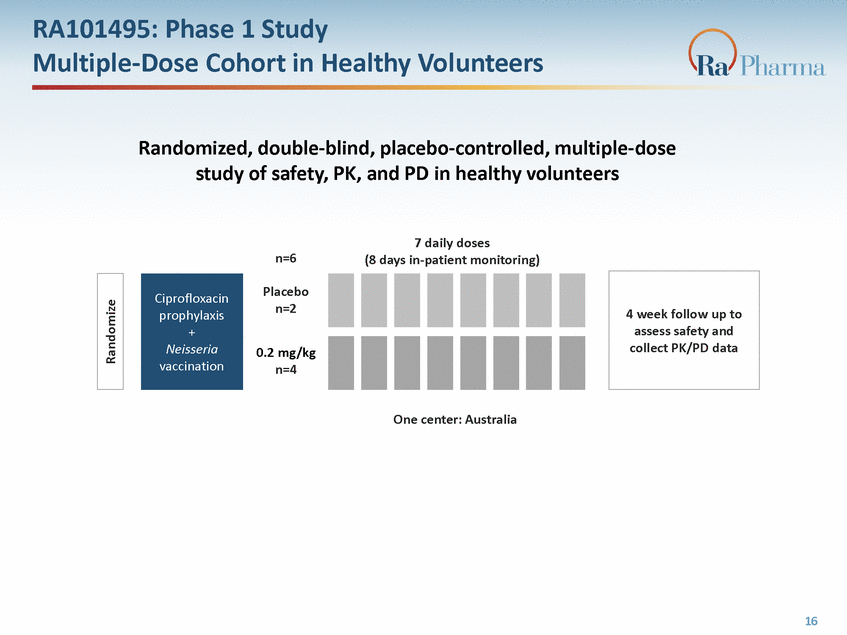
RA101495: PK Model Predicts Plasma Drug Levels In Phase 1 Multiple-Dose Cohort Modeling of non-human primates (NHP) and human (healthy volunteer) PK data accurately predicted observed results Consistent pharmacokinetics across all subjects with minimal variability in exposure At a 0.2 mg/kg dose level, RA101495 concentrations in plasma are expected to reach steady-state by day 11 (without a loading dose) Model vs. Actual Mean Plasma RA101495 Levels n=4 17
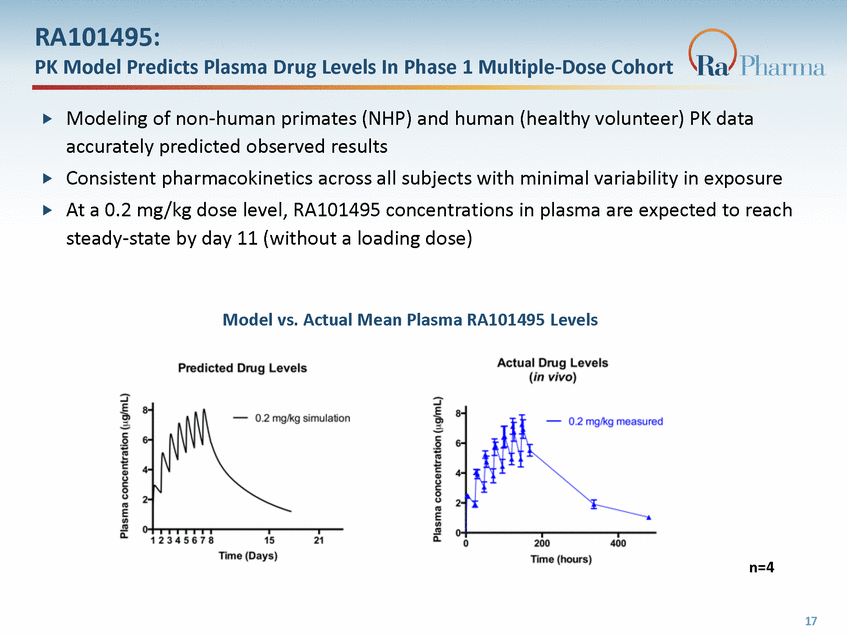
RA101495: Pharmacodynamics Robust Suppression of Hemolytic Activity in Phase 1 Multiple-Dose Cohort Suppression of hemolysis and complement activity was rapid, near-complete and sustained across the dosing period in all subjects Inhibition of hemolysis activity at D8 (24h after receiving the last dose) was observed to be >97% in all subjects Hemolysis activity returned to pre-dose levels within two weeks following the last dose n=2 (placebo) or 4 (0.2 mg/kg RA101495) dosed daily per group 18

RA101495 Protects Against Complement-Mediated Hemolysis of Type Dose response III PNH Erythrocytes Drug concentration No drug RA101495 No drug Eculizumab Flow cytometry Serum* Serum + HCl + Eculizumab (1 μM) Serum + HCl + RA101495 (1.2 μM) Serum + HCl Type III Type I+II *18h incubation of PNH RBCs with 50% acidified serum. PNH RBCs provided by Dr. Jaroslaw Maciejewski 19 Approx. 1 μM 101495 or Ecu (Note: Ecu is bivalent)
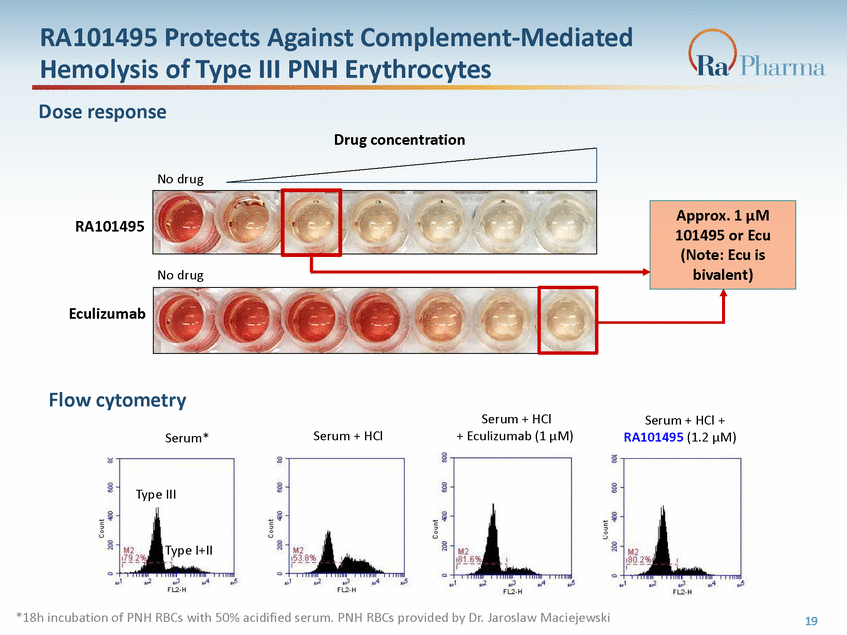
RA101495: Summary RA101495 is a potent inhibitor of complement C5, designed for convenient daily subcutaneous self-administration Single and repeat SC doses of RA101495 were well tolerated in healthy volunteers RA101495 displayed dose-dependent exposure and consistent and predictable pharmacokinetics, which were highly correlated with its pharmacodynamic effect (inhibition of hemolysis in ex vivo RBC lysis assay) The findings from single-and multi-dose administration studies confirm that daily dosing with RA101495 can achieve near-complete suppression of complement activity and hemolysis Phase 2 trial in PNH patients (eculizumab-naïve and eculizumab-treated) will commence dosing shortly with data readouts planned mid-year and year-end 2017 Received a positive opinion for orphan drug designation from EMA COMP for RA101495 for the treatment of PNH 20
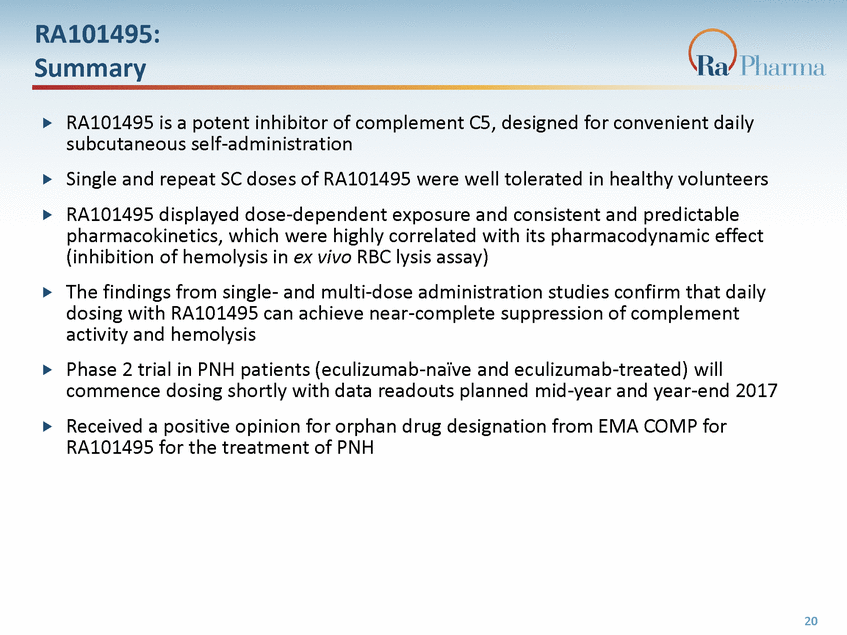
RA101495: PNH Planned Phase 2 Design Goal: To evaluate the safety, tolerability, efficacy, pharmacokinetics, and pharmacodynamics of RA101495 in subjects with PNH Design: Open-label (12 weeks) with long-term extension Global Program addressing 3 PNH populations Eculizumab Naïve Eculizumab Switch Eculizumab Inadequate Responders Primary Efficacy Endpoint: Change in lactate dehydrogenase (LDH) 21
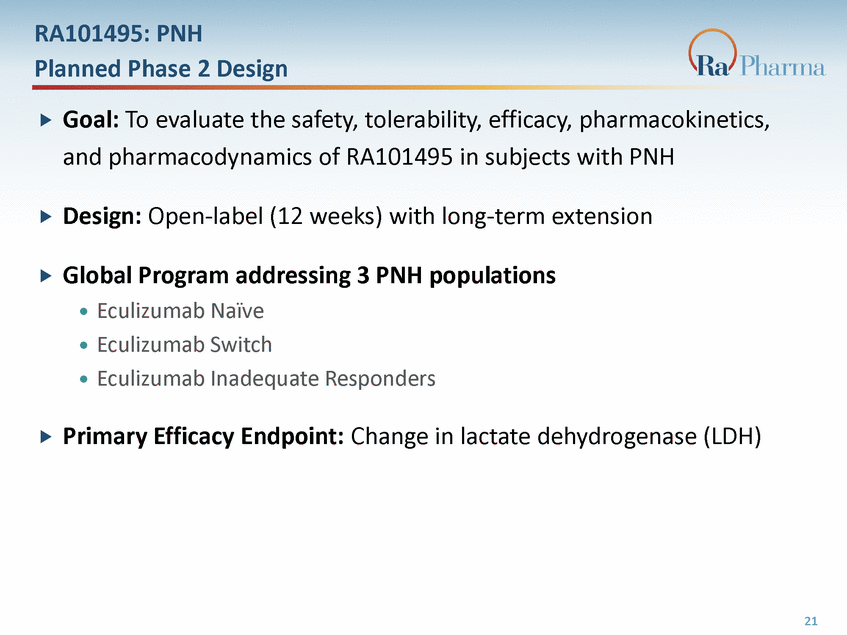
RA101495: Planned Phase 2 Design D1 W2 W6 W12 Cohort A (naïve) n=8-12 Review of safety & efficacy 0.3mg/kg Loading Dose Evaluation period for primary efficacy endpoint (change in LDH from baseline to mean of W6-12) W6 Extension Study D1 W2 W12 Cohort B (switch) n=6-8 Review of safety & efficacy 0.3mg/kg Loading Dose Evaluation period for primary efficacy endpoint (change in LDH from baseline to mean of W6-12) D1 W2 W6 W12 Inadequate Responders (LDH > 1.5 x ULN) n=6-8 Extension Study Review of safety & efficacy 0.3mg/kg Loading Dose Evaluation period for primary efficacy endpoint (change in LDH from baseline to mean of W6-12) 22 0.1mg/ kg, q.d. 0.1mg/kg, q.d. or up-titrate to 0.3mg/kg United States 0.1mg/ kg, q.d. 0.1mg/kg, q.d. or up-titrate to 0.3mg/kg 0.1mg/ kg, q.d. 0.1mg/kg, q.d. or up-titrate to 0.3mg/kg ROW
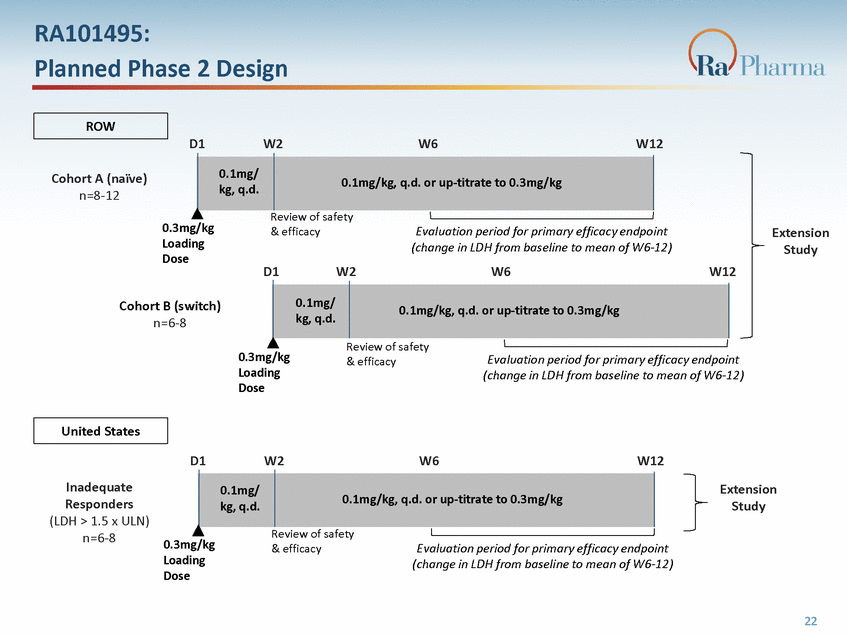
Daily Dosing Allows Maintenance of a Stable Drug Level as Compared to Bolus, Biweekly Dosing Daily administration greatly reduces risk of drop in plasma drug levels below minimally efficacious level Daily Dosed Drug weekly Dosed Drug Minimum level needed to prevent hemolysis 0 14 28 Day 23 Plasma Drug Levels Bi
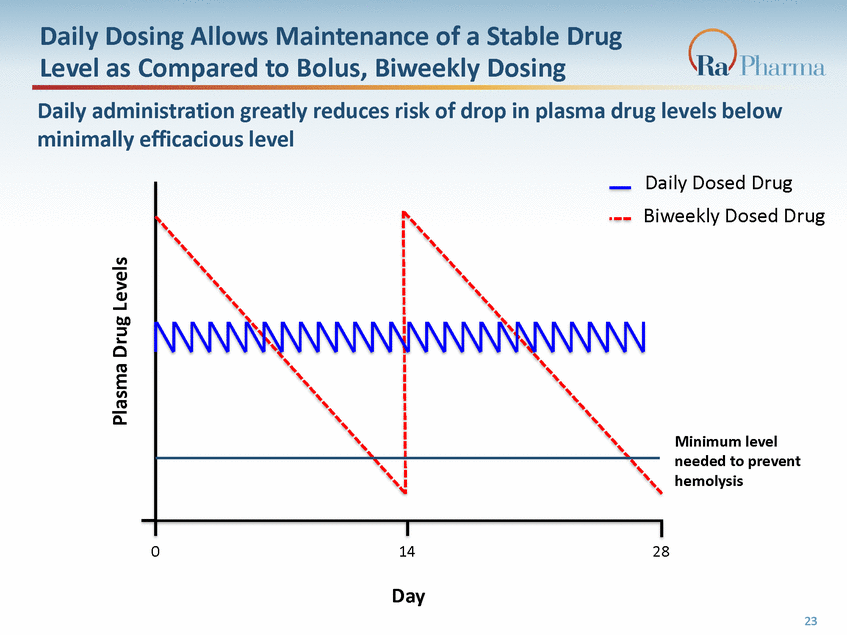
RA101495: Potential Advantages of a Macrocyclic Peptide Inhibitor of C5 Highly predictable PK, robust PD effects Linear relationship between dose and Cmax Observed from Phase 1 data to maintain >97% hemolysis suppression at 24 hours after last dose Weekly dosing considered feasible Improved control of hemolysis (Daily vs. high-dose biweekly IV infusion) Sustained suppression: dosing designed for continuous suppression (vs. bolus IV and decay over 2 weeks) Subcutaneous route of administration (vs. IV) Improved quality of life (Inconvenience and lack of freedom associated with IV infusion) Reduced complications of IV infusion (Infection, venous access, thrombosis, comfort of ports) Reduced treatment costs and reduced time/economic losses associated with home/clinic infusion Expanded target population (Distinct binding site vs. eculizumab) Treatment of patients with R885H/C mutations Synthetic product (non-recombinant) Non-biologic, essentially no risk of contamination by viruses and animal cell products Treat patients with hypersensitivity to CHO-derived products Novel mechanistic feature (vs. eculizumab) Potential to reduce complement damage mediated by other pathways 24
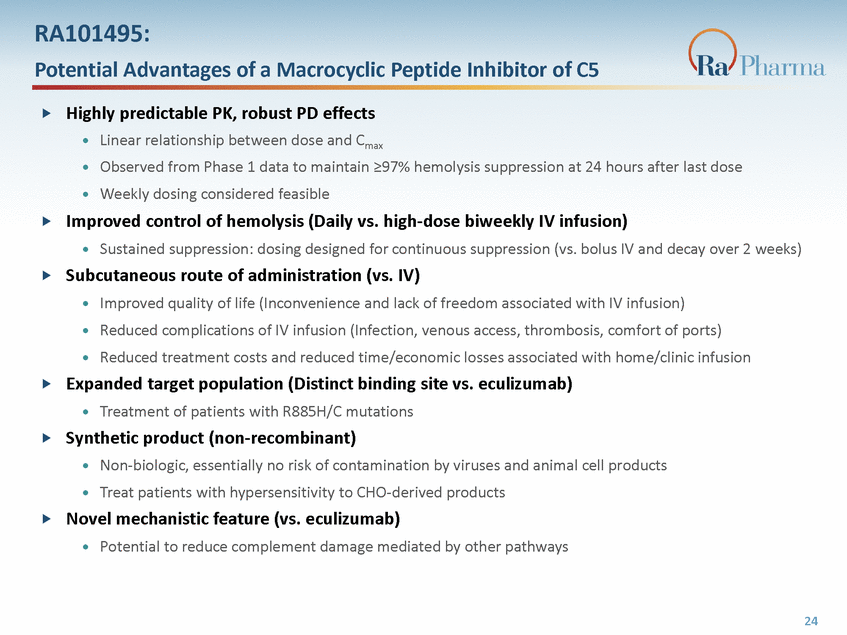
RA101495: A Well-Differentiated Profile For Treating PNH protein monthly Significant LFT high doses Not adequate for FcRn and C5 for technology Increased risks of infection and Insufficient Increased risk technology Potential to Soliris targeting liver C5 for missed doses saturation of hemolysis doses FcRn Additional PNH programs: Amgen (biosimilar), Regeneron (pre-clinical) 25 RA101495 ALN-CC5CoversinALXN1210LFG316RO7112689APL-2ACH-4471 Chemistry Target Administration Frequency Stage R885H/C Mutations Comments Cyclic peptide C5 SC Daily, (Weekly) Phase 2 ready Rapidly and potently inhibits hemolysis Convenient dosing Favorable PK RNAiTick salivamAbmAbmAbCyclic peptide Small molecule Liver C5 mRNAC5C5C5C5C3Factor D SCSCIV, SC IVIV, SCSCOral Weekly-monthly2x dailyEvery 8-weeksBiweekly/UnknownDaily2x daily Ph2Ph2Ph3Ph2Ph1/2Ph1Ph1 ExtremelyNot adequate monotherapyShort half-lifeFcRnsweepingmonotherapyliability in Ph1 ImmunogenicityrecyclingSimilar profile inhibition fromNo safety marginPotentialof infection onlysaturation ofFcRnVery highbreakthrough
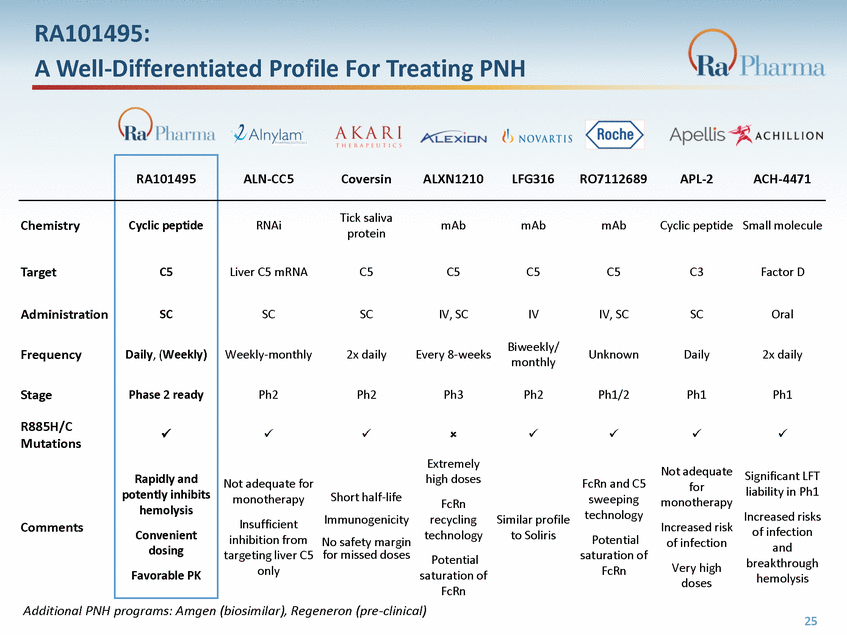
Complement Regulation Pipeline 26
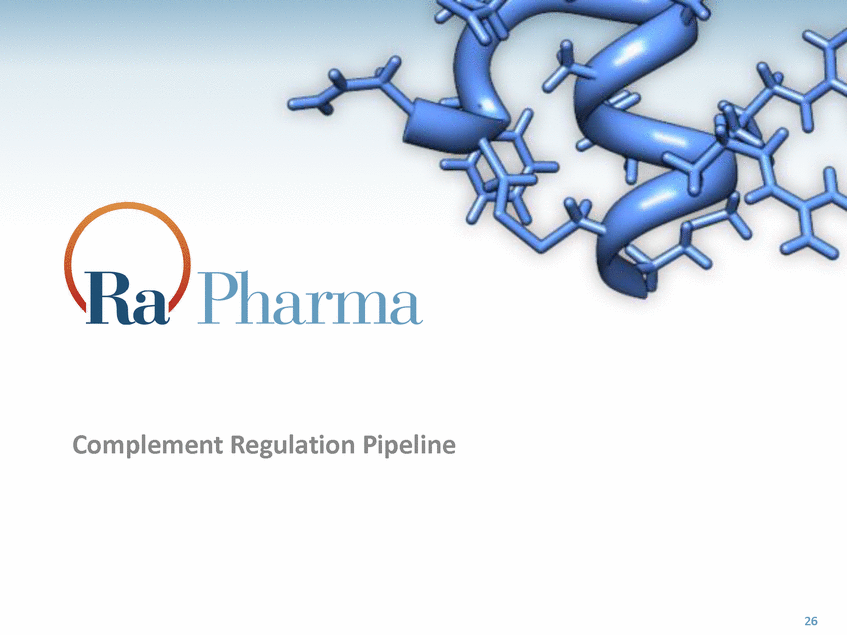
Building a Complement Inhibitor Franchise Technology enables development of a portfolio of C5 inhibitor candidates suitable for chronic or acute indications Can vary PK properties and route of administration Allows different pricing structures for different indications Life cycle extension plan for C5 inhibitors Weekly (depot) formulation Druggability of RA101495 binding site has been used to identify true small molecule inhibitors of C5 Leveraging RA101495 preclinical, CMC and Phase 1 data packages to efficiently pursue other indications in parallel: Lupus Nephritis (LN) Refractory Myasthenia Gravis (rMG) – LN affects approximately 63,000 patients in the United States Approximately 10%-15% will develop end-stage renal disease, requiring a kidney transplant or initiation of dialysis – rMG affects approximately 9,000 patients in the United States Current therapies do not target injury caused by complement attack Inhibiting terminal complement activity may block complement–mediated damage – – – – Binding C5 may prevent progression of kidney disease in LN by blocking complement-mediated damage to kidney cells Applying mRNA Display platform to other targets (Factor D, C1) Dry AMD/GA, orphan renal diseases (DDD and C3GN), autoimmune/CNS diseases 27
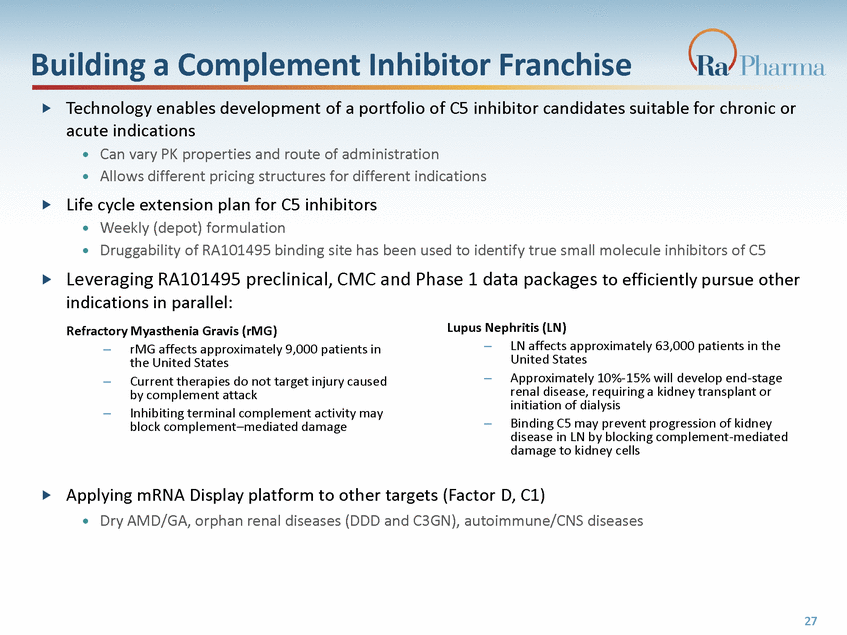
Next Generation of C5 Inhibitors: Orally Bioavailable Small Molecules Series of orally bioavailable (%F=30) small molecules that bind C5, inhibit its cleavage/activation (IC50 14 nM in sheep RBC lysis assay), and prevent hemolysis of PNH erythrocytes in a dose dependent manner Serum + HCl + Eculizumab Serum + HCl + RAX-4110 Serum* Serum + HCl Type III Type I+II RAX-4110 concentration High resolution co-crystal structures of SM inhibitors bound to C5 available Complete understanding of mechanism of action Enables structure-guided optimization *18h incubation of PNH RBCs with 50% acidified serum. PNH RBCs provided by Dr. Jaroslaw Maciejewski 28
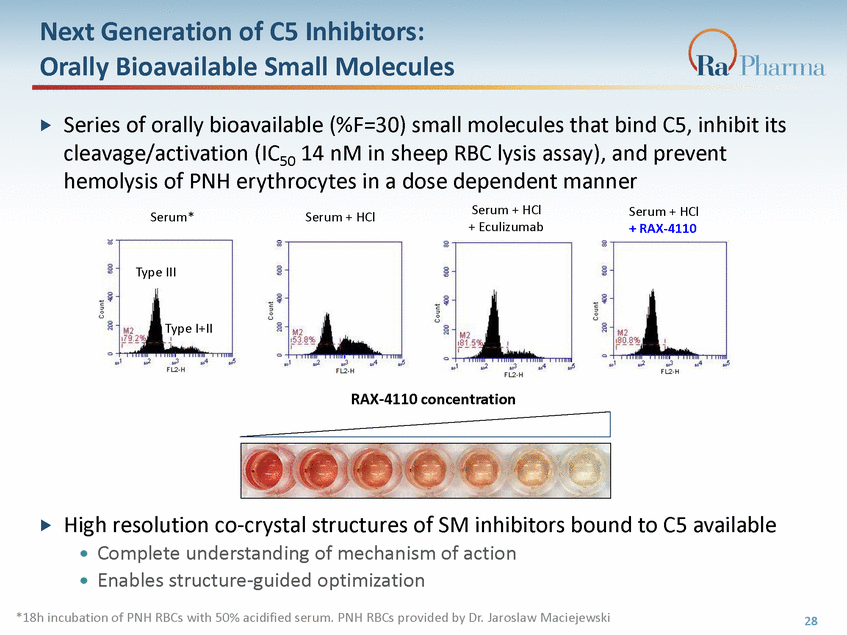
Therapeutic Use Of Factor D Inhibitors Factor D (FD) is a critical mediator of alternative pathway activation Cleaves Factor B bound to C3b, generating C3 convertase (C3bBb) FD Potential indications: Dense deposit disease/Membranoproliferative Glomerulonephritis type II/C3 Glomerulopathy (High priority) –Uncontrolled activation of alternative pathway results in glomerular C3 deposition –Mutations/polymorphisms in complement genes associated with increased risk Dry age-related Macular Degeneration (High priority) –Polymorphism in complement regulatory factor H is risk factor for AMD1 –Positive Ph 2 data in geographic atrophy with anti-Factor D (Lampalizumab, Roche) Extravascular hemolysis in PNH patients treated with C5 inhibitor (Lower priority) –Reduce C3 fragment coating on PNH RBCs and subsequent spleen phagocytosis (extravascular hemolysis, EVH) –Potential for increased risk of infection may limit investigator interest 1. Klein, R., et al, Science, 2005 29

Factor D: Developing Multiple Molecules for Two Potential Value Streams Highly potent inhibitors (low nanomolar) Physical Properties Solubility and Stability (PBS, Plasma, and Log D etc. Vitreous) In vitro DMPK Microsomes, retinal pigmented epithelium stability, CYP profile (including retinal CYPs) Intravitreal (Dry AMD) Low plasma stability Lipophilic Vitreal solubility Microsomal and RPE stability Systemic/SubQ (DDD/C3GN) High plasma stability 30

Selective Inhibition of the Classical Pathway: C1 Macrocycle Project C1 Complex and subunits Multiple approaches to inhibition of C1 complex C1q has an emerging number of non-complement functions Clearance of apoptotic cells and immunogenic debris Tolerance induction in dendritic cells Anti-proliferative effect on T-Cells and inhibition of B-cell signaling Ra macrocycle selections have targeted C1s specific and dual C1s/C1r binding peptides to potentially avoid broad non-complement effects of C1q Preclinical evaluation underway Potential Indications and Competition 31 Indication Incidence Competition/Status Cold agglutinin disease ~1 in 80,000 Anti-C1s TNT-009 (TrueNorth) / Ph1 Soliris (Alexion) / Ph2 Warm autoimmune hemolytic anemia ~1 in 100,000 Anti-C1s TNT-009 (TrueNorth) / Ph1 Fostamatinib (Rigel)-oral Syk inhibitor / Ph2 Rituximab (Roche) / Ph3 Neurodegenerative disease (AD, HD, ALS, GBS) e.g. AD ~5.4 million in US as of 2015 Anti-C1q (Annexon) / Pre-clinical
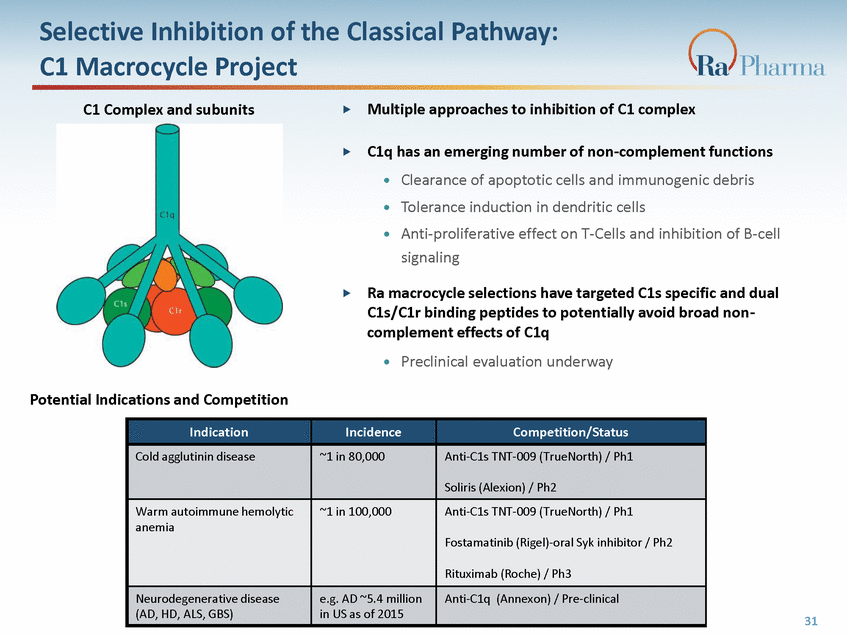
Financial Summary $117.8 million in cash and cash equivalents as of December 31, 2016 $105.4 million gross proceeds raised in October, 2016 initial public offering $95.7 million net proceeds Collaboration with Merck represents opportunity for additional milestone and royalty payments Delivered orally-available cyclic peptides for a non-complement cardiovascular target with a large market opportunity, now in development at Merck $17.5M received to date; with additional potential milestones of up to $61.5M and royalties 32
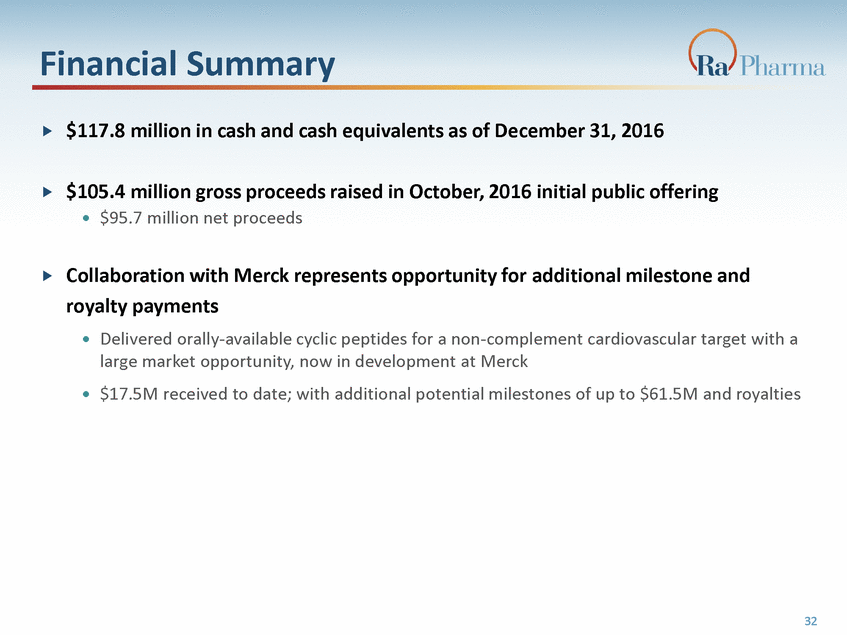
Upcoming Clinical Milestones Regulatory and IRB approval for Phase 2 PNH program 1Q17 Site activation for Phase 2 PNH program 1H17 Commence dosing for Phase 2 PNH program 2Q17 Data readouts for Phase 2 PNH program Mid-and YE ‘17 Initiate Phase 2 study in rMG 2H17 Initiate Phase 2 study in LN 2H17 33
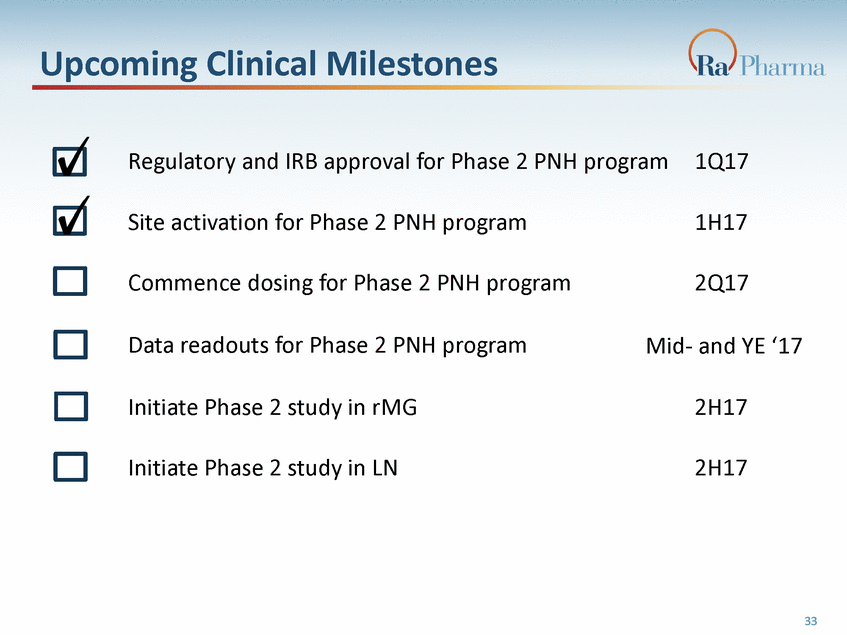
Investment Highlights Focused on complement-mediated diseases Addressing rare hematologic, renal, neurologic indications, as well as ocular and autoimmune Lead clinical program: RA101495 for paroxysmal nocturnal hemoglobinuria (PNH) Potent, synthetic macrocyclic peptide inhibitor of complement C5; Distinct binding site vs. eculizumab Convenient self-administered subcutaneous dosing Completed Phase 1 safety, PK, and PD study in healthy volunteers –Rapid, sustained, near complete suppression of hemolysis and complement activity Received orphan drug designation from European Medicines Authority (EMA) Phase 2: Regulatory clearance from FDA and ex-US agencies, IRB approvals received, site activation underway, dosing to commence shortly Powerful proprietary drug discovery engine Enables application to diseases with high unmet medical need and/or for which only mAbs have previously been successful Delivered orally-available peptides for a non-complement cardiovascular target with a large market opportunity in our collaboration with Merck $117.8 million in cash and cash equivalents as of December 31, 2016 $105.4 million gross proceeds raised in October 2016 initial public offering 34
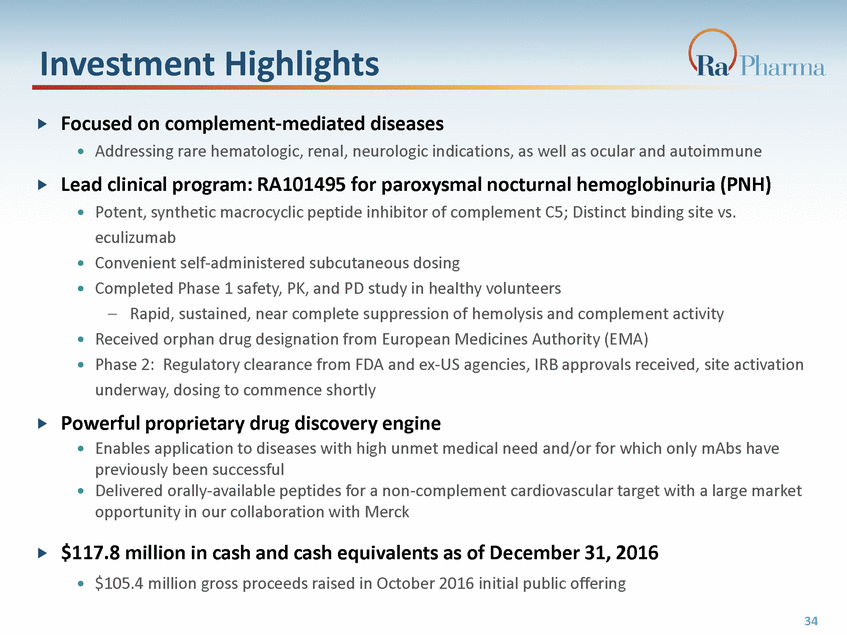
Contact: Jen Robinson Senior Director, Investor Relations & Corporate Communications jrobinson@rapharma.com 35

